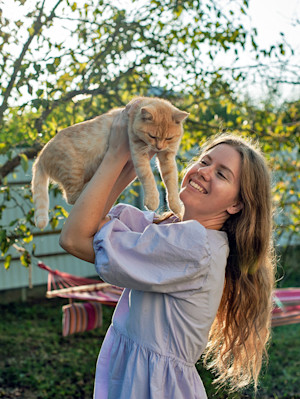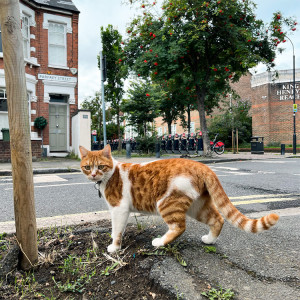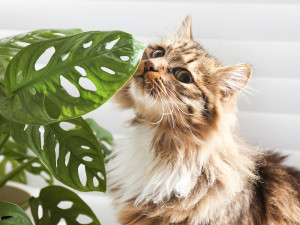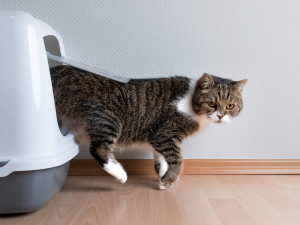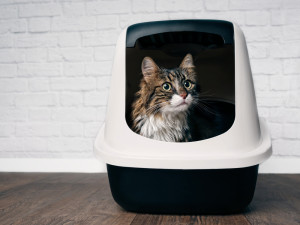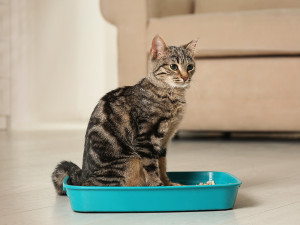How To Stop Your Cat Pooing in the Garden
Are faeces in your flower beds ruining your garden?
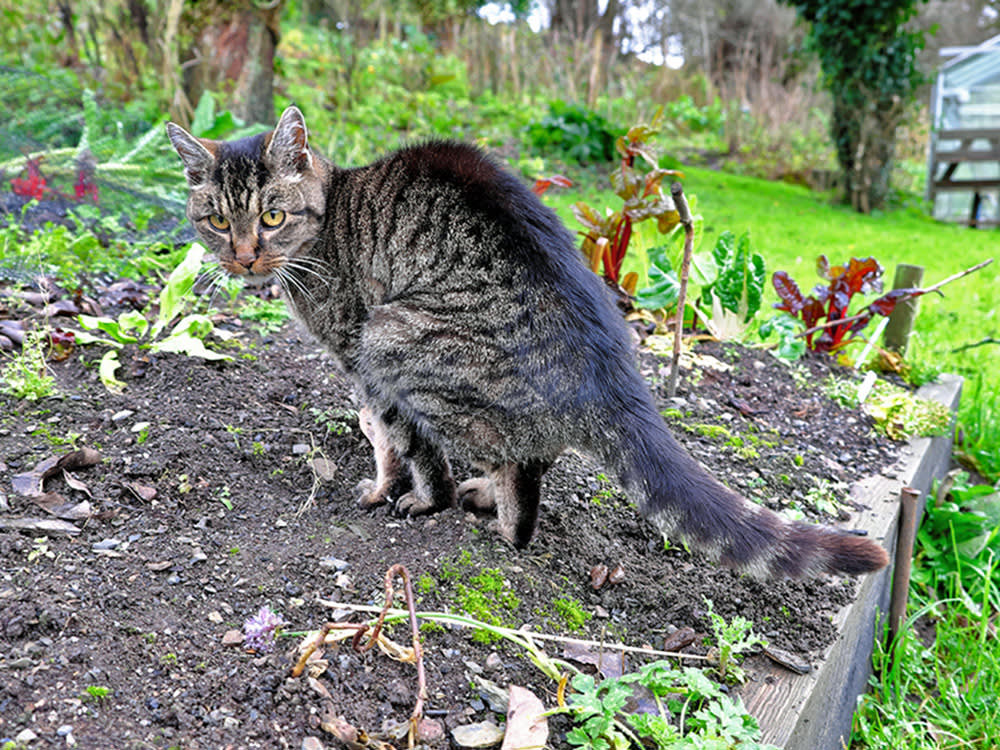
Share Article
For many gardening enthusiastsopens in a new tab, it can be a frustrating sight to watch your cat dig up your freshly planted flowers and do a poo in the soil – even worse when it’s not even your cat but a pooping feline bandit from the neighbourhood.
While there might not be a miracle cure for this garden nuisance, there are a few cat-safe deterrents you can implement – but before finding a solution, it’s important to understand why this flower bed defecation is happening in the first place.

littleKin™ is Kinship’s home just for puppy and kitten parents. Bop over to check out expert advice, new pet tools, and special deals—all curated for your newest family member.
opens in a new tabWhy do cats poo outside?
Although many cat parents provide litter traysopens in a new tab inside for their felines, cats may still choose to use the toilet outside for a number of reasons:
Natural instincts: cats have a natural instinct to dig and bury their faeces. Gardens with loose soil provide an ideal environment for this behaviour. Burying their waste helps cats keep their living area clean and reduces the scent that might attract predators.
Territorial marking: our feline friends communicate using various different tools, including olfactory cues that allow them to ‘suss out’ who’s who in their territory. Defecating in a specific area can be a way for cats to mark their territory – the scent from their faeces acts as a signal to other animals that the area is occupied. Middening, which is the act of cats leaving uncovered faecesopens in a new tab, can often be used as a territorial marker.
Preference for softer surfaces: gardens often have soft, loose soil, which is easier for cats to dig in compared to harder surfaces like concrete or gravel. This makes freshly turned flower beds a preferred spot for many cats. Likewise, well-kept lawns can also prove a cat favourite as the soft spongy grass is gentle on their paws.
Outdoor access: for cats that have access to the outdoorsopens in a new tab, a garden is a convenient and natural place to relieve themselves. It allows them to follow their instincts in a familiar environment.
Habit and routine: if a cat has developed a habit of using a particular spot in the garden, they will continue to do so out of routine.
How to stop cats pooing in your garden
Whether your own cat is the pooing culprit or it’s down to other local felines using your garden as their communal toilet, following these steps may help to reduce the problem. All cats are different and so one method might prove successful where another might not, meaning you may have to experiment with a few. Remember, only ever use kind, gentle methods so that you’re never causing harm!
Odour deterrents
A cat’s sense of smellopens in a new tab is very sensitive, so using an odour that they don’t like can be enough to deter them. Add any of the following to water and spray them on the areas of your garden you want to remain faeces-free: lavender, peppermint, cinnamon, lemons, limes or oranges. You can also use finely chopped citrus fruit and scatter these around.
Lion pee/dungopens in a new tab is available as a fertiliser, which contains a scent that cats will associate with predators. Banana peel and fruit can also be used, as can chicken manure, both of which provide added nutrients to your plants. Avoid using garlic, coffee, vinegar and bleach, which are all harmful to catsopens in a new tab.
Create obstacles
Make your garden difficult for other cats to enter by adding shrubs to your fences, like roses. Having higher fences, blocking off entry or exit holes into your garden and cat-proofingopens in a new tab the space using inverted netting can also prevent sneaky neighbourhood felines from entering. This method will also stop your own cat from getting out, so only use it if you want to prevent roaming and secure your cat in your garden.
You can also try covering the soil around your plants with things that cats will find uncomfortable to walk on such as crushed up eggshells, pine cones, bark, twigs or pebbles.
Plant choice
Cats hate a variety of plantsopens in a new tab and will naturally avoid them, whether that is due to their scent or because they are spiky. Try planting some of the following: rosemary, lavender, lemon balm, quince, roses and scaredy cat plant (yes that does exist!) You can also try planting things closer together so that there is less space for cats to get into the soil and start digging.
Use sprinklers
A motion detector sprinkleropens in a new tab will spray water if it detects a cat moving around in the garden. Cats will generally choose not to get wet, so if they get sprayed once, they will likely avoid the area in future. This technique is probably best if you have an inside cat and the cat poo in your garden is coming from other felines, as you ideally don’t want to create a negative association with your garden as a whole for your kitty.
Create a designated outside toilet
If it is your own cat that is the problem pooper, then consider providing a suitable area outside that you are happy for them to go to the toilet in. Either with an outdoor litter trayopens in a new tab or in a specified area where you’ve placed something inviting like soft soil or sand.
Make sure the area is private, so they can hide and feel safe. If you are trying to discourage other cats, this may not be a good option as it could be very inviting for all the other cats in your neighbourhood, which will certainly lead your cat to feel more stressed if there’s an influx of other felines enjoying your outside bathroom!
Keep your garden watered
As soil dries, it makes flower beds more appealing because the soil becomes easier to dig. If you keep the beds wet, cats are less likely to walk on, dig up and poo on them. You could consider using an irrigation watering pipe in flower beds to facilitate this.
Remove poo
Getting rid of any poo that you do find can help, as cats are more likely to be attracted to areas they have used before.
Other tips
If you notice your cat looking suspicious around your flower beds or starting to dig, calmly try to redirect them. Likewise, if you see them using a designated area or outdoor litter box, then offer positive reinforcement with treats to encourage them to repeat the desired behaviour.
If you find that your kitty favours going outdoors and not using their inside trayopens in a new tab, it could be time to look into your current litter tray set-up. Maybe the location is wrong, they don’t like the litter you’re supplying or the design of the tray doesn’t suit them. Understanding why your cat is exhibiting a specific behaviour can often go a long way towards making them more comfortable and provide clues on how to create an environment that supports their health and emotional wellbeing.

Zoe Blake RVN, ISFMCertFN / AdvCertFB, MISAP
Zoe is a registered veterinary nurse and has been in the profession for over 30 years. She enjoys educating pet owners on all aspects of their care and regularly writes to support her work. When she is not chatting animals, she can be found running around the tennis court or exploring the countryside with her rescue dog, Dylan.
Related articles
![cat coming out of litter box]() opens in a new tab
opens in a new tabWhat to Do When Your Cat Refuses to Use the Litter Box
A cat behaviourist explains why they’re so particular about where they pop a squat
![]() opens in a new tab
opens in a new tab5 Litter Box Enclosures That Aren’t Total Eyesores
Keep your cat’s litter box out of sight – but easy to clean
![]() opens in a new tab
opens in a new tabHow To Create a Cat-Safe Garden
Green fingers at the ready
![a cat peeks out of a litter box lid]() opens in a new tab
opens in a new tab5 Litter Boxes Your Cat (Probably) Won’t Reject
Think like a cat when choosing a litter box... so you can go back to not thinking about litter boxes
![Cat sitting in a teal litter box]() opens in a new tab
opens in a new tabMastering the Art of Litter Box Training: How to Train Cats to Use a Litter Box
If you do nothing else, teach your cat to poo in their litter box (and not in your shoe)
